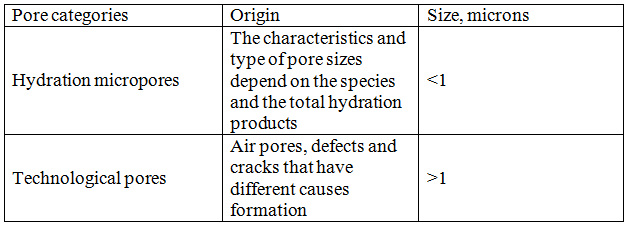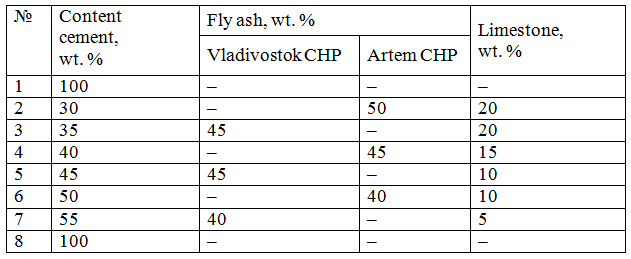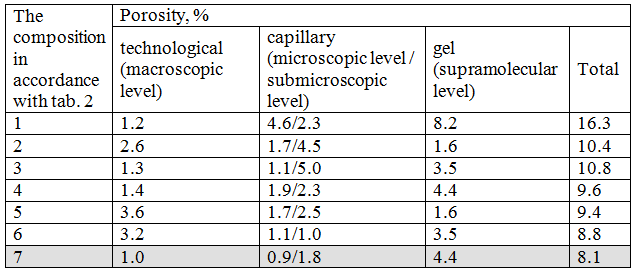RESEARCH ON POROSITY OF THE CEMENT STONE OF COMPOSITE BINDERS
Федюк Р.С.1, Храмов Д.А.2
1 ORCID: 0000-0002-2279-1240, Старший преподаватель, 2 Студент, Дальневосточный федеральный университет
ИССЛЕДОВАНИЕ ПОРИСТОСТИ ЦЕМЕНТНОГО КАМНЯ НА КОМПОЗИЦИОННОМ ВЯЖУЩЕМ
Аннотация
В статье представлены результаты определения пористости цементного камня. Определен ряд положительных факторов, способствующих улучшению физико-механических характеристик цементных композитов за счет введения кремнеземсодержащих добавок.
Ключевые слова: пористость, цементный камень, композиционное вяжущее.
Fediuk R.S.1, Khramov D.A.2
1 ORCID: 0000-0002-2279-1240, Senior lecturer, 2 Student, Far Eastern Federal University
RESEARCH ON POROSITY OF THE CEMENT STONE OF COMPOSITE BINDERS
Abstract
The article presents the results of determining the porosity of the cement stone. It identified a number of positive factors that contribute to the improvement of the physical and mechanical characteristics of cement composites by introducing the silica-containing additives.
Keywords: porosity, cement stone, composite binders.
Numerous studies have found that the physical and mechanical properties of the cement stone: strength, deformability, permeability, frost resistance, etc. Are in direct relation not only to crystalline growths in a cement stone structure, but also on the size, configuration and number of pores. Concrete is a capillary-porous material permeated the pores and capillaries of different sizes.
According to L. Sarcar Shondeep [1], the origin of the pores in the cement stone, its size and type can be represented as follows (tab. 1).
Table 1 – Pore categories of cement stone
In the present study was to investigate the character of pores in the cement stone near complementary methods:
- Small-angle X-ray diffraction measurement range 2´10– 3… 3´10–1 microns;
- Mercury porosimetry measures the range 1´10–1…4´10 microns;
- Optical microscopy with a measuring range 4´10…1´103 microns.
As part of the work it was formed 7 composite binder formulation. In each of them was added hyperplasticizer PANTARHIT PC160 Plv (FM) in an amount of 0.3% (tab. 2).
Table 2 – Binders compositions
The results determine the porosity of the samples of the cement stone are shown in tab. 3. According to these data, the total porosity of the samples of the composite binder half in comparison with the control composition is also different distribution pattern of pores of different diameters.
Table 3 – Research on the cement stone porosity
Porosity, especially submicroscopic level decreases with increasing dosage ash and hyperplasticizer. The lowest porosity of the capillary is fixed in a sample of the composite binder number 3, which is apparently due to the higher ash content.
Using one of the known classifications of cement stone structure on the level of dispersion [2], conventionally divided pore space in the pores of the samples studied supramolecular (1´10–3<d<5´10–3 microns), submicroscopic (5´10–3<d<1´10–1 microns), microscopic (1´10–1<d<4´10 microns) and macroscopic (4´10<d< 2´103 microns) levels.
Technological porosity - a decrease in the percentage of cement in the composite binder increases. At the same time samples of cement stone with the same number of two types of ash have almost the same porosity on the macroscopic level (4.0 ... 4.2), which obviously depends on factors unrelated to the chemical properties microfillers.
The supramolecular level to fit the pores of the gel; formed disperse most tumors which mainly determine the strength of the cement stone. In the second level gets the bulk of the hydration neoplasms and capillaries, which are mainly determined by the water and gas-tight cement stone. Microscopic level includes some tumors, such as Ca(OH)2, structural defects in the form of cracks and macro capillas also affect the strength and permeability of cement stone. Macroscopic level is characterized by technological defects and cell properties - entrained air, shells etc.
From fine fly ash introduced into the concrete mix, contributes to the formation of dense aggregates of intergranular space and less defective contact zone aggregates with cement stone in the process of deepening hardening.
Pozzolanic-reaction leads to the transformation of Ca(OH)2 in finely divided hydrous and reducing pore size. The consequence of the pozzolanic reaction is to improve the adhesion to aggregates and reducing the porosity of the contact zone.
With the introduction of the additive gel pore volume varies depending on the type and dosage of components and hyperplasticizer. By reducing the dosage of fly ash from 50 to 40% of the total weight of the composite binder, the porosity of the gel compared with the control sample increases by 3.4 ... 6.2%. The increased number of hyperplasticizer increases the gel porosity of 3.2%. To a lesser degree in the gel porosity affects the form of fly ash. The difference between the extreme values of the porosity at the same dosages of fly ash and mixtures plasticity only 1.8%. However, the ash samples containing high amount of silica, and the binder in the composite having the largest dispersion, gel porosity still higher.
Analysis of the microstructure (Fig. 1) showed that the cement stone with the optimal dosage of components is characterized by a dense matrix consisting of low basis hydrosilicates calcium, while cement stone without additives presented a highly basic calcium hydrosilicates and hexagonal plates portlandite. Accordingly, with an increase in dosage of silicon additives increase the degree of hydration of cement content low basis hydrosilicates calcium and strength of cement stone. The same dependence is observed with increasing dose hyperplasticizer. Some slowdown in the degree of hydration with increased dosage hyperplasticizer up to 14 days due to the shielding effect of an excess amount of organic additives in the early stages (Fig. 1 b).
Fig. 1 – Microstructure of composite binders
Comparison of the phase composition of cement paste with different content of additives showed that the most favorable in terms of increasing the degree of hydration, hydration phase and strength of cement is a binder composition of the composite sample number 7 (tab. 2).
Investigation of the effect of silica additive on the interface and the filler in the cement stone concrete ductile found that in the intermediate zone between aggregate and cement matrix not containing micro (nano) silica thin foamed layer is observed, which is found in the pores of ettringite and CSH. Such a layer is absent in the concrete with micro (nano) silica-containing additive.
Thus, the study of the microstructure was determined by a number of positive factors that contribute to the improvement of the physical and mechanical characteristics of cement composites by introducing the silica-containing additives:
- hardened contact area between cement stone and aggregate in concrete;
- accelerates the curing process of the cement stone at an early stage by performing silica component of the role of crystallization centers;
- an increase in the concentration and dispersion of the filler in terms of helping to reduce the overall porosity of the cement paste;
- additional hydrosilicates are formed by interaction amortized silica component part obtained by milling with Ca(OH)2 released during the hydration of alite;
- due to the high surface energy of the particles of silica component are generated clusters "binding - filler."
References
- Sarcar Shondeep L., Diatta Yaya. Autcin pierre-claude. Microstructural study of aggregate / hydrated paste interface in very high strength rivel gravel concretes // Bond. Cementitious Compos.: Symp., Boston, Mass., Dec. 2 – 4, 1987. Pittsburgh. – 1988. – P. 111 – 116.
- Ratinov V.B., Rosenberg T.I. Concrete admixtures. - M .: Stroyizdat, 1989. - 188 p.




